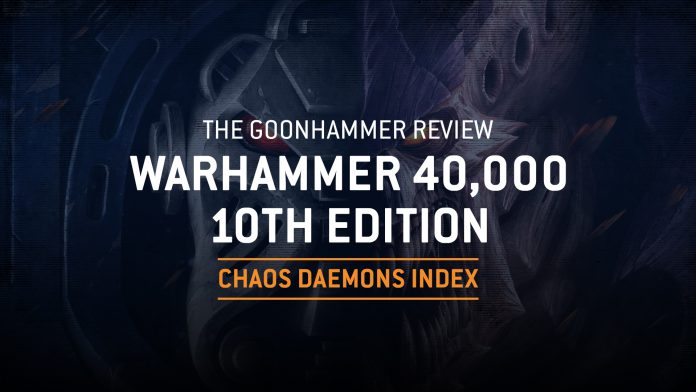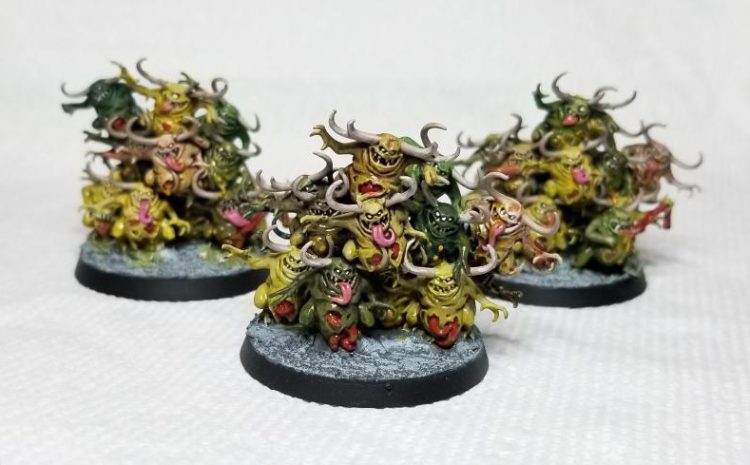Daemons are a unique army in the lore, and they should play in a unique way on the tabletop. Even more than Daemon players want their army to be good, they want their army to be weird.
This is something that the Chaos Daemons 10th Edition index has partially accomplished… albeit with varying degrees of success across the different Gods. In this article we’ll look at the new rules in Index: Chaos Daemons, the units, and how they’ll play on the table.
Before we begin we’d like to thank Games Workshop for providing us with a review copy of the Index for review purposes.
We’d also like to thank Mike Pestilens from the Chaos website Warphammer for guest writing this article. Mike wants Chaos fans to know that while Warphammer is temporarily down as they deal with some tech issues after being hacked, they’re close to getting that resolved and will be back and better than ever in time for 10th Edition!
Army Rule: The Shadow Of Chaos
The Shadow Of Chaos is a thematic army rule, based around the idea of Daemons reshaping realspace into a terrifying mirror image of the Warp. While the Shadow Of Chaos doesn’t innately do anything, it synergizes with all sorts of other rules in the codex, and is a key part of how this army will function in 10th Edition. The Shadow Of Chaos can be divided into 3 areas of the battlefield:
- Your Deployment Zone: This is always considered to be in the Shadow Of Chaos. As above, so below.
- No Man’s Land: If you control at least half of the objective markers in No Man’s Land at the start of a phase, then No Man’s Land is considered within the Shadow Of Chaos.
- Opponent’s Deployment Zone: If you control at least half of the objective markers in your opponent’s deployment zone, then his/her deployment zone is considered within the Shadow Of Chaos.
The important thing to keep in mind is that Shadow Of Chaos checks at the start of a phase, not continuously. This will have some implications on other rules that synergize with the Shadow Of Chaos, in both positive and negative ways.
Daemonic Manifestation and Daemonic Terror are additional army-wide rules. They showcase both the immaterial form of Daemons, and the terror they inflict upon mortals.
- Daemonic Manifestation: If your unit is within the Shadow Of Chaos, add 1 to Battle-shock rolls, and every time you pass a Battle-shock test, heal d3 wounds (return d3 models instead if it is a Battleline unit)
- Daemonic Terror: If an enemy unit is within the Shadow Of Chaos, subtract 1 from Battle-shock rolls, and every time they fail a Battle-shock test, take d3 mortal wounds.
This doesn’t seem impressive on the surface, but with the huge emphasis on battleshock in 10th Edition overall, this is a very solid foundation for Daemons to build from. Let’s see what else this index has in store.
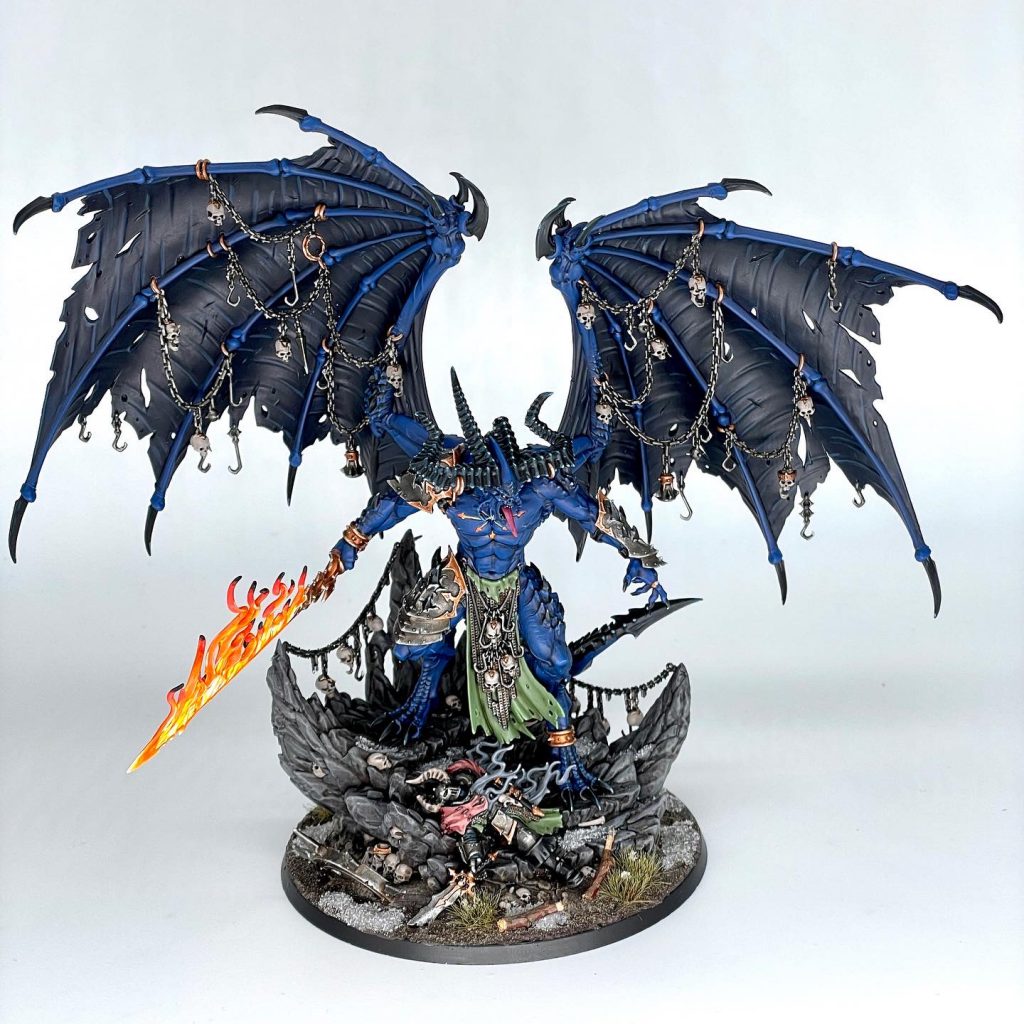
Detachment Rule: Daemonic Incursion
Detachment Ability: Warp Rifts
Warp Rifts will be familiar to anyone who used daemonic deepstrike shenanigans in 9th Edition, although those shenanigans are returning in a simplified and generally weaker form. Warp Rifts means that whenever you are set up wholly within your army’s Shadow Of Chaos using the Deep Strike rule, you can set up 6” away from the enemy instead of 9” away.
Warp Rifts is a powerful rule on the surface, and combos incredibly well with some of the charge bonuses Daemons have access to. With many units having +1 to Charge or access to Charge rerolls of some sort, Daemons will be one of the few armies in the game with reliable deepstrike charges.
Keep in mind that Shadow Of Chaos checks at the start of the movement phase, before you have moved any models. This means that if you’re planning to deepstrike into No Man’s Land in the following turn, the opponent can prevent you from using Warp Rifts in No Man’s Land by walking onto at least half of the objectives during their own turn. Of course, it isn’t quite that simple. Daemons have some additional ways to project the Shadow Of Chaos (such as an aura and a stratagem that will be discussed later), and you can always prevent the opponent from controlling half the objectives on their turn by killing their front units or move-blocking them. Just be aware that your opponent has some counterplay to Warp Rifts. You also have some counterplay to their counterplay.
Instead of always having one gameplan you stick to every game, you’ll have to adapt and actually play some 40K. This is a good thing, not a bad thing.
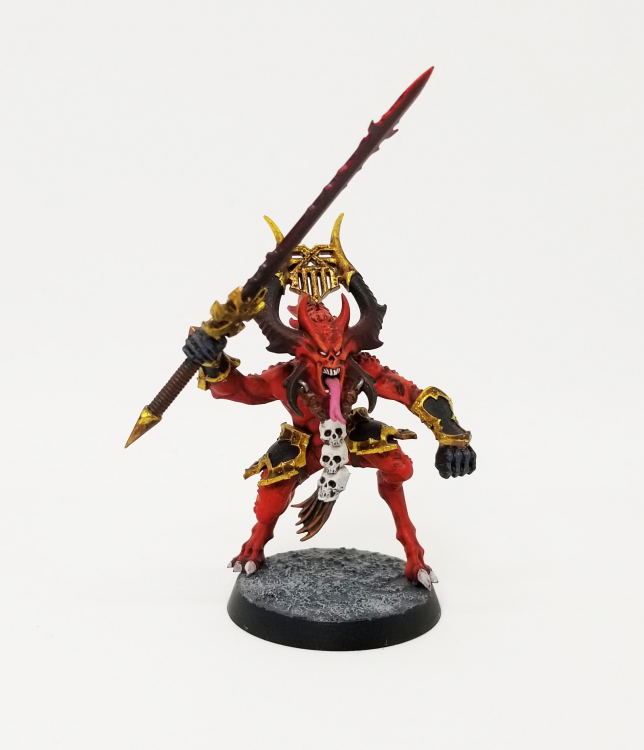
Enhancements
Each God is represented here once, with 4 Enhancements in the index that each play into a strength of their respective God. They also have synergy with the Shadow Of Chaos rule, adding another level of strategy to how you use your units.
My personal favorite is the Endless Gift. The Endless Gift gives the bearer a 5+ Feel No Pain that becomes a 4+ Feel No Pain while they are within the Shadow Of Chaos. The Grandfather has truly given us a special gift with this Enhancement.
Soulstealer is a great choice for those who prefer a more decadent Enhancement. Soulstealer lets you roll a dice every time you destroy an enemy model in melee. On a 4+ (or a 3+ while you are in the Shadow Of Chaos), you heal a lost wound. Nothing like snacking on a few Elves to keep your Keeper Of Secrets invigorated during battle!
A’rgath, King Of Blades gives you +1 Strength and +1 Attack on your melee weapons, doubling those effects while you are in the Shadow Of Chaos. This isn’t incredible, but it’s a very nice upgrade on a Bloodthirster with the Great Axe Of Khorne, getting you back up to Strength 18 to wound T9 Vehicles on 2’s.
The Everstave gives your Lord of Change’s ranged weapons +1 Strength and +3” range, doubling those effects while you are in the Shadow Of Chaos. These effects also stack with a Lord Of Change’s innate aura of +1 Strength for ranged weapons. This means that a Lord of Change’s Bolt Of Change, which is Strength 9 base, can go up to Strength 12 with the Everstave. Not bad at all for a 9 shot, AP2, d3 damage gun.
Stratagems
The Stratagems in Index: Chaos Daemons are a complete success, adding both flavor and power to our daemonic arsenals. They cover a wide variety of scenarios, and you’ll end up using (or at least thinking about using) every one of them every single game. The best part is that every single stratagem costs just 1CP, meaning you’re going to have plenty of good choices available to you every turn.
Looking to get up close and personal with the enemy? Denizens Of The Warp has you covered. This stratagem allows you to Deep Strike a mere 3” away from the enemy, with the restriction that you can’t charge that turn. This will come in handy for sniping vulnerable units with Tzeentch Flamers, or flipping an objective with some OC2 or OC3 Plaguebearers.
Looking to do extra damage? Pop Draught Of Terror to drive your Daemons to inflict even more cruelty. Your unit gets +1 Armour Penetration on their attacks. And that’s not all–if the enemy unit is Battle-shocked, your unit gets full Wound rerolls. Priced at 1CP, your units like Soul Grinders, Bloodcrushers, Pink Horrors, and Seekers are all going to use this often.
My personal favorite is Daemonic Invulnerability. This is just some good old-fashioned Daemonic fun, letting one of your units reroll invulnerable saves of 1 for a Shooting Phase. Want to soak an entire army’s worth of damage? Pop your once-per-game 3+ invuln on your Daemon Prince, and then sprinkle Daemonic Invulnerability on top. Results nearly guaranteed.
Corrupt Realspace is simple but effective, letting you retain control of an objective until an opponent controls it, even if you walk away from it. It also makes the area of the board within 6” of the objective market part of the Shadow Of Chaos. Warp Surge lets any Daemon unit advance and still charge, with the restriction that you have to be in the Shadow Of Chaos when you start your charge. The Realm Of Chaos lets any Daemon unit (or two units if they are both in the Shadow Of Chaos) leave the battlefield at the end of the opponent’s turn, returning to Deep Strike during your following turn. This isn’t the flashiest stratagem, but has a ton of versatility and on that I expect good players to use often.
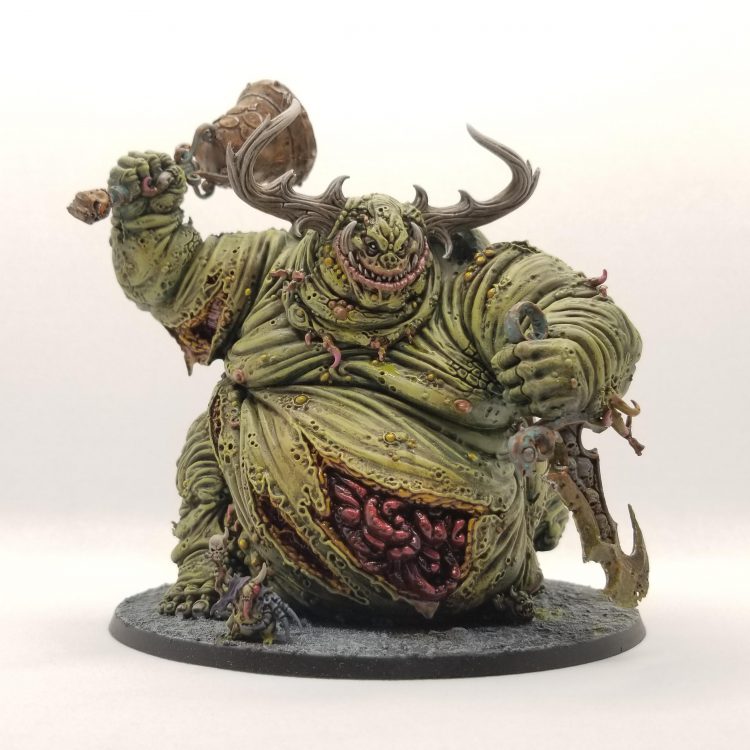
Datasheets
There are a few general trends you’ll notice across the various Daemon datasheets.
One of my favorite changes is the return of Instruments to their 8th Edition and earlier form, as they now provide +1 to Charge rolls for units that can take them again. With Icons improving Leadership by 1, both upgrades provide real benefits for the units carrying them.
You’ll also notice that 9th Edition’s “Daemon Saves” are entirely gone. They have been replaced with invulnerable saves again, which makes sense given 10th Edition’s overall reduction in “ignores invulnerable save” units and weapons. These new invulnerable saves don’t differentiate between ranged and melee attacks anymore, and are one flat value for every unit. This has both pros and cons for Daemons players. For example, Pink Horrors come out as winners, with a permanent 4++ invuln instead of a 3++/6++ Daemon Save. While they’re less durable against ranged attacks, they will no longer wilt when touched in melee. You’re more likely to survive long enough to split. Not all units benefit, however. Units like Plaguebearers and Bloodletters going to a 5++ invuln from their 4+/5+ Daemon Save leaves them more vulnerable to shooting. This doesn’t mean that they’re bad, just that the transition from Daemon Saves to invuln saves didn’t benefit all units equally. The split is generally “Greater Daemons with a 4+/5+ went to 4++ invulns, and all other Daemons with a 4+/5+ went to 5++ invulns”.
Neither fortification has an invuln save, which seems very odd given that literally every other Daemon unit has one, including Daemon units with actually decent armour saves like Horticulus Slimux. I would not be shocked if this was an omission that is fixed in an eventual FAQ.
With all of that out of the way, let’s dive into the datasheets. To make this section easier to follow, we’ll break down the units by their respective Gods.
Unmarked Units
- Be’lakor (10/10): The Dark Master returns in peak form, bringing incredible synergies to any Daemons list. He has 3 auras he can choose from at the start of the battle round. 2 of them either improve your own Battle-shock tests or force your opponent to take some, but the real star of the show is Wreathed In Shadows. This aura makes it so that any Daemon unit within 6” of Be’lakor cannot be targeted by opposing models while they are more than 18” away. This is just game-winning in some matchups. Any area of the battlefield within 6” of him is also considered to be in your Shadow Of Chaos, which helps your other army rules function. Do note that Be’lakor has lost his God keywords instead of having all 4, which reduces buffs available to him from other units.
- Soul Grinders are the real deal, getting to choose from 1 of 4 special shooting loadouts depending on their God mark. The most intriguing option is Nurgle’s Phlegm Bombardment, which has Indirect Fire to clear out objectives that you can’t get to with your melee units. It also gained the Scuttling Walker rule to walk over friendly Monsters/Vehicles and terrain less than 4” in height. This is very situational, but is still cool.
- Daemon Princes received a glowup to accompany their new model. Both versions come with a Heavy Bolter equivalent gun, helping them chip in some ranged damage. The walking version is a buff piece, coming with a 6” aura of Stealthy for your units. With a one time use 3++ invuln save for a phase, it can soak up a ton of damage when the time is right. The winged version is more of a melee beatstick, gaining your choice of Lethal Hits/Precision/Sustained Hits 1 every time it fights. It also can increase its Attacks characteristic by 3 once per game. You also gain some slight benefits to different stats depending on which God mark you pick.
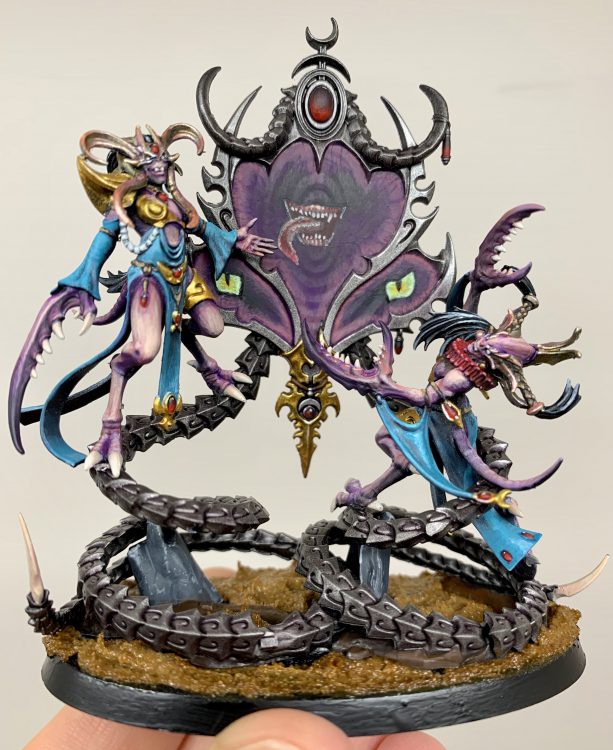
Slaanesh Units
- Shalaxi has absolutely shown up to play in the new codex. With full hit, wound, and damage rerolls on her d6+2 damage Soulpiercer with Precision, she is going to rip gaping holes in even the toughest units in the game. She also has an innate Feel-No-Pain 5+ rule, meaning she gets free access to the whip wargear in addition. Combined with the fact that her Pavane Of Slaanesh gets Sustained 3 on its supercharged version, Shalaxi actually brings some non-negligible shooting to the table. The downside is that she doesn’t have -1 to Hit like other Keepers, meaning she is a bit more vulnerable to being shot off the table.
- Keeper Of Secrets have a new role in the new Index, going from melee monsters to more buff/durability pieces. With T10 (same as Shalaxi), a 5+ Feel No Pain from the Shining Aegis, and an innate -1 to Hit, they’re tougher to kill than ever. Their aura of +1 Armour Penetration for your Slaanesh units will help your Fiends and Daemonettes shine. The downside is that the Strength of her attacks didn’t increase at all in the new edition. S8 attacks with the Witstealer sword are much less attractive when they wound Rhinos and Storm Speeders on 5’s.
- Daemonettes have lost an attack, a point of AP, and 1” of movement in exchange for gaining innate Hit rerolls of 1 (full Hit rerolls near objectives) and Devastating Wounds. With several ways to access wound rerolls in this index, Daemonettes will have a ton of mortal wound output when they spike. Going back to a permanent 5+ invuln does leave them very vulnerable to enemy shooting again.
- Syll’Esske, the Contorted Epitome, Tranceweavers, and the Infernal Enrapturess all lead Daemonette squads now. Of those, my favorite is Syll’Esske, who stands back up when they first die on a 2+ roll now–with their full wounds healed. They also let Daemonettes proc their mortal wounds on a 5+ to Wound. My one gripe is that they got no glow-up in Strength on their attacks. Strength 7 on the main axe will really disappoint in some cases. The Contorted Epitome lost damage in melee and all buffs in exchange for interfering with one enemy unit’s shooting while they are within 12” during the opponent’s shooting phase. The timing of this rule makes it very situational, and I’m hoping the Epitome got a real points drop to reflect its new datasheet. The Infernal Enrapturess continues to have the game’s most unexpected lascannon, but lost most of its other cool rules. It now returns d3 Daemonettes just in the squad it is leading, as well as making nearby enemy psychic attacks Hazardous. The Tranceweaver is probably the real winner out of all of these Leaders. It gives its Daemonettes squad Fights First, which is so powerful in 10th Edition. It also gives your entire army Hit and Wound rerolls against one nearby Battle-shocked enemy unit.
- Fiends return relatively unchanged, gaining Devastating Wounds and +1 Toughness in exchange for -2” Movement. Soporific Musk also gained a slight tweak, improving to a 6” aura.
- The chariots have very similar stats to before, with the main changes coming to their special abilities. They have all lost their -1 to Hit versus Ranged attacks, making them more vulnerable to being shot. We’ve also lost 2 of the 3 Tormentbringer options, with the only Character version option now the Tormentbringer on Exalted Seeker Chariot. That version gives all nearby units Sustained Hits 1 and lets a friendly unit fight on death on a 4+, both great buffs. Normal Exalted Seeker Chariots make nearby enemies take Battle-shock tests after it kills a unit. Seeker Chariots gain Anti-Infantry 4+ on all of their weapons after making a charge. Hellflayers are swingy but powerful. When they are selected to fight, you roll a d6. On a 2-3, you do d3 mortal wounds. On a 4-5, you do 3 MW. And on a 6, you do 3+d3 MW. You add 2 to the roll if you pick an Infantry unit, so in practice you’re doing 3+d3 MW on a 4+ if you pick an Infantry unit. Not bad at all.
- Seekers are the hidden gem of the Slaanesh arsenal. Gaining Scout 9”, they give you an option for early board control and easy access to turn 1 charges if you go first. With innate Advance and Charge rerolls, they’ll get where you need them to go.
Nurgle Units
- Great Unclean Ones are the star of the Nurgle show. With a 6” aura of 6+ Feel No Pain for your Nurgle units, they’ll help your army stay on the board. With T12 and access to the Endless Gift enhancement on one GUO for a 4+ Feel No Pain while within the Shadow Of Chaos, they’re finally the walking tanks they were meant to be. Their damage output will be a bit disappointing, as the Strength of their attacks is capped at 7 or 8. At least it has Lethal Hits on every single weapon option. It also debuffs the toughness of one nearby enemy unit at the end of your Movement phase, giving your entire army a buff versus one target.
- Rotigus is the more offensively oriented GUO build. He picks a visible enemy unit within 18” each fight phase, and gives all of your Nurgle units +1 Damage against that unit. He also halves the Movement and Objective Control of enemy units within 6”. No access to the Endless Gift leaves him much more vulnerable to taking damage than the normal Great Unclean One, however.
- Plaguebearers return almost unchanged, losing 1 AP on their Plagueswords in exchange for letting you retain control of objective markers after they walk off of them.
- Nurglings are… weird. They are Battleline and Infiltrate, which is nice. They also have a 6” aura of -1 to Hit in melee for enemy units. There is one glaring issue, however: They have 0 Objective Control. This is a crushing blow. You’ll stick take a unit or two if they’re super cheap to disrupt the enemy early, but they’re no longer the early tempo piece they once were.
- Plague Drones and Beasts Of Nurgle both got a Toughness glowup, going to T8 and T9 respectively. Beasts Of Nurgle lost their 6” Heroic Intervention rule, but have kept their full healing at the end of every phase and mortal wound output in melee. Plague Drones gained a special rule for their Death’s Heads ranged attacks, giving all of your Nurgle Daemons full wound rerolls for the rest of the turn after an enemy unit is hit by them. With largely 4+ WS and Lethal Hits, it generally wasn’t the Wound roll that Nurgle Daemons were struggling with, but its still a nice buff to have.
- The Feculent Gnarlmaw gives nearby Nurgle units Stealth, helping them stay on the board versus shooting. This isn’t a bad rule to have access to, but its very points dependent. Unless the Gnarlmaw is less than half of the points of a walking Daemon Prince, you’ll probably just find the points for the Daemon Prince instead. The Daemon Prince has the same rule while also being a very powerful piece in its own right. OC0 means that the Gnarlmaw’s Infiltrate rule isn’t as useful as it could have been.
- Poxbringers, Scriveners, Epidemius, and the Sloppity Bilepiper all attach to Plaguebearer units. Poxbringers are probably the least useful, letting your Plaguebearers Lethal Hits proc on a 5+ to Hit and subtracting 1 from Battle-shock tests for nearby enemies. Spoilpox Scriveners are going to be useful for their +1 to Objective Control for your Plaguebearer unit, helping you swarm objectives and keep some OC even while Battle-shocked. Epidemius makes your Plaguebearer unit slightly more durable with a 4+ invuln save, and lets you generate 1CP whenever your tally of models killed reaches 7. Sloppity helps your mobility, giving your Plaguebearer unit +1” Movement and letting you re-roll Advances. Nearby enemy units must also take Battleshock tests in the fight phase.
- Horticulus Slimux leads a unit of Beasts Of Nurgle atop his speedy snail. Coming in at T10 with 10 Wounds and a 4+ invuln, he has become a real tank in this index. He also transforms a terrain piece into a permanent Shadow Of Chaos when he moves within it. He also lets your Beast Of Nurgle unit use the Heroic Intervention stratagem for free, as well as letting it reroll charges. As long as he is costed appropriately, he’ll have a role in your Nurgle Daemon lists.
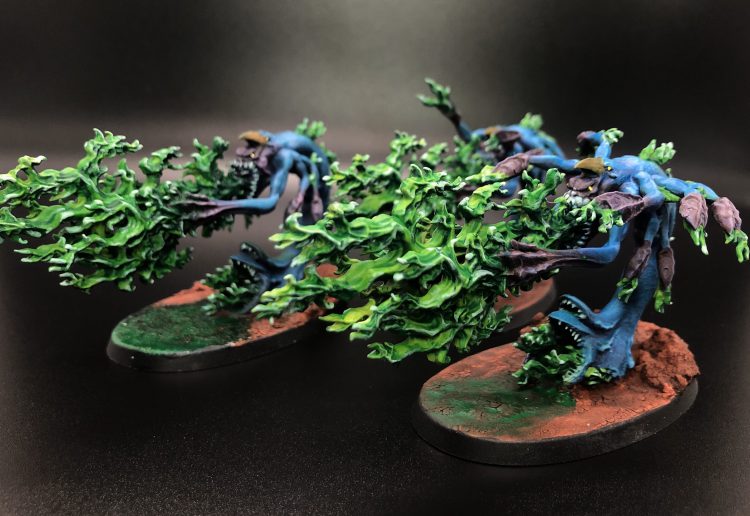
Tzeentch Units
- Pink Horrors are the star of the show, and will be an elite tarpit as long as they don’t get a big points increase. They are almost identical to their 9th Ed iteration, trading a 3+/6+ Daemon Save for a permanent 4+ invuln. They are now a great screen and objective holder versus melee armies, too.
- Blue Horrors got a surprisingly huge glow-up. They now Infiltrate, and have OC1 unlike Nurglings. They also have a 4+ invuln like Pinks, and gain an additional rule for -1 Leadership for nearby enemies.
- Kairos is now the game’s coolest looking artillery piece, gaining a powerful shooting attack with the Indirect Fire keyword. He also lets you roll a d6 every time you use a stratagem on a nearby unit, giving you 1CP if your roll is higher than the current battle round. In addition, he messes with the opponent’s CP, increasing the cost of a stratagem once per game after an opponent uses it. Kairos seems like a great option for both Undivided and Tzeentch armies. T10 will help him stay in the fight once he comes out to play.
- Lords Of Change seem powerful, albeit less interesting than they were before. With an aura of +1 Strength for ranged attacks, he helps all of your Tzeentch units hit harder. The option to choose between Lethal Hits, Ignores Cover, and Sustained Hits D3 gives his own Bolt Of Change some versatility.
- The Blue Scribes continue to be known as the datasheet that gets wildly different rules each edition. They now come with a 6” aura of mortal wounds to enemy units, and debuff nearby enemy Psychic attacks with -1 to Wound. Their main value is in the Lone Operative keyword, preventing them from being targetted unless the enemy is able to get very close.
- Scratch that. The Changeling might be the unit whose rules change most every time they get a new datasheet. Being a Lone Operative with Stealth, the Changeling will be tough for opposing shooting armies to kill. He also has the ability to give an enemy unit within 12” in the opposing shooting phase -1 to hit, or even stop it shooting entirely on a 6, but that’s quite situational. The coolest part of his datasheet is that every time an enemy wants to select The Changeling as the target of an attack, they must take a battle-shock test. If they fail the test, that unit is battle-shocked, takes d3 MW if they’re in the Shadow Of Chaos, and can’t target the Changeling.
- Flamers have shifted from your main sources of damage output into more of a skirmishing role. Going from 12” move with Assault weapons to just a 9” move greatly reduces their threat range. They lost -1 Strength and -1 AP on their attacks and went from 3+d6 to just d6 shots, all serious nerfs. In exchange, they re-gained their auto-hitting flamers, and now ignore cover on their shots. They also can shoot after they Fall Back. A flat 4+ invuln also means they aren’t as scared of being touched in melee, and can actually tie up opposing units. You’ll still want some Flamers in any Tzeentch focused list.
- Exalted Flamers lead units of Flamers now, giving both units the Assault keyword back on their weapons. They also roll a dice after hitting a non-Monster/Vehicle enemy unit, subtracting 2” from that unit’s movement, charge rolls, and advance rolls if you roll a 4+. Spicy!
- Screamers return almost entirely unchanged, losing the teleport but keeping the flyover damage.
- Burning Chariots return almost unchanged, losing a bit of movement in exchange for gaining T8. Their special rule turns off the benefits of cover for an enemy unit that they hit until the end of the phase. This is an odd choice, given that Flamers, Exalted Flamers, and Burning Chariots already ignore cover.
- Fateskimmers lead Screamer units now. Their damage output and buff utility isn’t what it once was, and they’re just T7 unlike Burning Chariots. The main reason you’ll want to bring a Fateskimmer is for the Rider Of The Immaterial Winds ability, which lets you pick up the unit at the end of the opponent’s movement phase and deepstrike during your following turn.
- Changecasters and Fluxmasters lead Pink Horror and Blue Horror units now. Changecasters are offensively focused, giving your Horrors Sustained Hits and making an enemy unit take a Battle-shock test after being hit by your Horrors. Fluxmasters are defensively focused, making your Horrors -1 to Hit and changing one of his own Hit, Wound, or Saving throws to a 6 every battle round. Both units seem valuable.

Khorne Units
- Bloodcrushers are the stars of the Khorne show, becoming a durable T7 with a 4+ invuln. Their mortal wound impact strat is now baked into their datasheet, doing d3 MW on a 4+ per model in the unit. They have lost an attack, but their horns now get +1 to Wound on the charge.
- Bloodletters return almost entirely unchanged, picking up reroll 1’s to wound in exchange for becoming a bit easier to shoot with only a 5+ invuln.
- Flesh Hounds are are now your (literal) guard dogs. They no longer have +1 damage on the charge, but now they can use the Heroic Intervention stratagem for free, and even if other units already used it. Their psychic deny has shifted to a 3+ Feel No Pain against psychic attacks.
- Karanak leads a unit of Flesh Hounds, giving them rerolls to their advance and charge rolls. His Prey Of The Blood God ability now lets you pick a new target whenever the current one dies, but its so situational that it’ll rarely come up.
- Skull Cannons come in at a spicy Toughness 9 with Strength 9 on its cannon. It has lost ignores cover and a pip of AP, but now forces a unit shot by it to take a battle-shock test. It has also gone up to 2+d6 shots, meaning you can do a ton of damage if you roll well.
- The Skull Altar will see exactly as much play in 10th as it did in 9th. Coming in at T12 with 10 wounds, it’s very durable. And that’s all it does. It does Infiltrate and let nearby areas of the battlefield count as being in the Shadow Of Chaos, as well as let nearby units reroll battle-shock tests, but unless it’s very cheap there is no real reason to bring it.
- Skulltaker and Bloodmasters can lead Bloodletter squads. Skulltaker is the superior option of the two, giving his squad Devastating Wounds and being a powerful beatstick himself into Characters with Precision. Bloodmasters give their unit +1 to Wound and +3” to their Consolidation moves.
- Skullmasters basically function as an extra large Bloodcrusher in the squad, forcing charged enemies to take battle-shock tests instead of mortal wounds. They also give all of the juggernaut horns in the squad Devastating Wounds, letting you sprinkle a few extra mortal wounds on top of their usual offensive output.
- Rendmasters on Blood Throne are powerful buff units. They pick one visible enemy unit within 18” at the start of the fight phase, and all of your Khorne Daemons get +1 AP, +1 Strength, and +1 Damage versus that unit. Whatever they mark for death is dying.
- Skarbrand continues to be a beatstick, bringing 8 flat 6 damage attacks to the table. His aura of rage now only gives +1 Attack to friendly Khorne Daemon non-Monster/Vehicle units, meaning you’re no longer accidentally buffing the enemy. He still requires nearby enemy units to make a leadership check before falling back, but that is less useful for himself now that Monsters can be shot in combat. Coming in at T11, he’ll still require some real effort to kill.
- All 3 Bloodthirster variants have been rolled into one datasheet. Fortunately, it’s a pretty great datasheet. The Great Axe is still the way to go, bringing 7 D6+2 damage attacks to the table. They also give off an aura of +1 to Hit in melee for Khorne Daemons, making all of your smaller daemons hit on 2’s in combat. Their Relentless Carnage rule now averages ~4MW to a unit they are in combat with at the end of the fight phase, meaning they can charge one unit, kill it, and then do some real damage to another unit by consolidating into it.
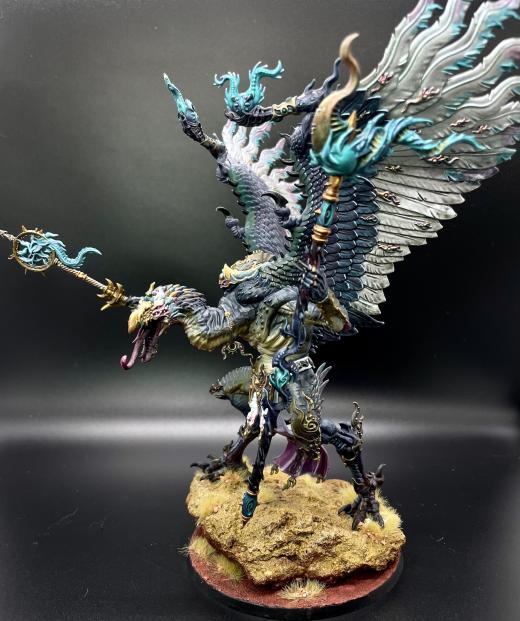
The Five Biggest changes from 9th
- All Greater Daemons can now be hidden behind terrain. Keepers, Bloodthirsters, Great Unclean Ones, and Lords of Change don’t have the Towering keyword. This means they can be hidden behind terrain from alpha strikes. Given the high mobility of 3 of the 4 God’s Greater Daemons, starting behind terrain and then popping out to dominate the midboard seems like a smart plan. Even though Be’lakor technically isn’t a Greater Daemon, this definitely applies to him too.
- Warpstorm Table is entirely gone. I’ll miss the powerful buffs available. I won’t miss the turns I rolled 1 or 2 Warpstorm points and didn’t get to actually use any of those powerful buffs.
- Deepstriking closer now relies on the Shadow Of Chaos, not Leadership. This also means we don’t get to deepstrike 3” away from enemies while in our own deployment zone. Deepstriking 6” away from enemies in our deployment zone is still pretty cool, however.
- Charge rolls have been buffed across the board. There are a ton of charge rerolls or +1” to charge modifiers in this codex. You’ll have lots of very reliable 6” or 5” rerolling charges out of deepstrike.
- Our invulns versus shooting have largely become worse. Our invulns versus melee have largely become better. With variable Daemon Saves being removed in favor of one flat invuln save per unit, our defensive profiles have been simplified. The good news is that with “ignores invuln” effects being almost entirely removed from the game, our invuln saves will actually feel like invuln saves again. Note that Daemons aren’t hypocrites about this: Our three big sources of “ignore invulns” damage ourselves, Skarbrand, Be’lakor, and Skulltaker, have all lost their “ignore invulns” rules.
Wrap Up
You’ll notice that none of the rules mentioned so far make any mention of mono-God bonuses. That’s not an omission. There are in fact no army rules in Index: Chaos Daemons that explicitly encourage or discourage you from sticking to just one God instead of running an Undivided army.
That doesn’t mean you have to run Undivided. Far from it! If you love running your mono-faction Nurgle Daemon, Tzeentch Daemon, Slaanesh Daemon, or Khorne Daemon army, you are more than welcome to do so. You’ll receive the benefit of a more synergistic army, with the buffs you’ve brought benefitting a higher proportion of your army. For example, when a unit like Plague Drones gives wound re-rolls to every Nurgle Daemon unit in your army, you’re incentivized to bring lots of other Nurgle Daemons when you’re bringing Plague Drones. You’re just not punished if you also want to bring a Lord Of Change for some additional ranged damage, or some Seekers to cap objectives.
This index gives you the flexibility to play your entire Daemons collection. While I hope we get rules that provide additional benefits for mono-God armies (and I’d love to see Disciples Of Be’lakor make a return), Index: Chaos Daemons is a great start for Daemons players in 10th Edition.
Have any questions or feedback? Drop us a note in the comments below or email us at contact@goonhammer.com.
